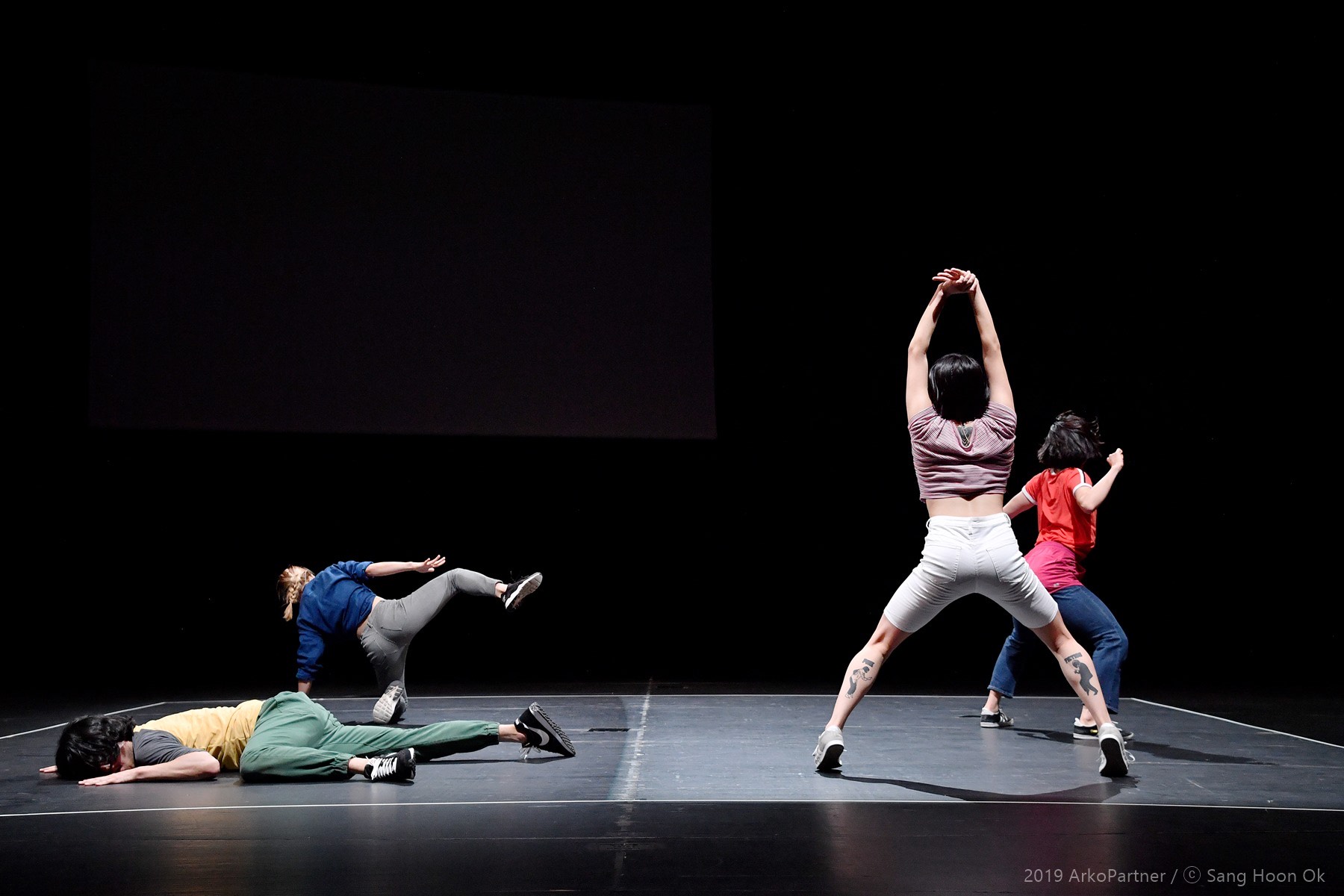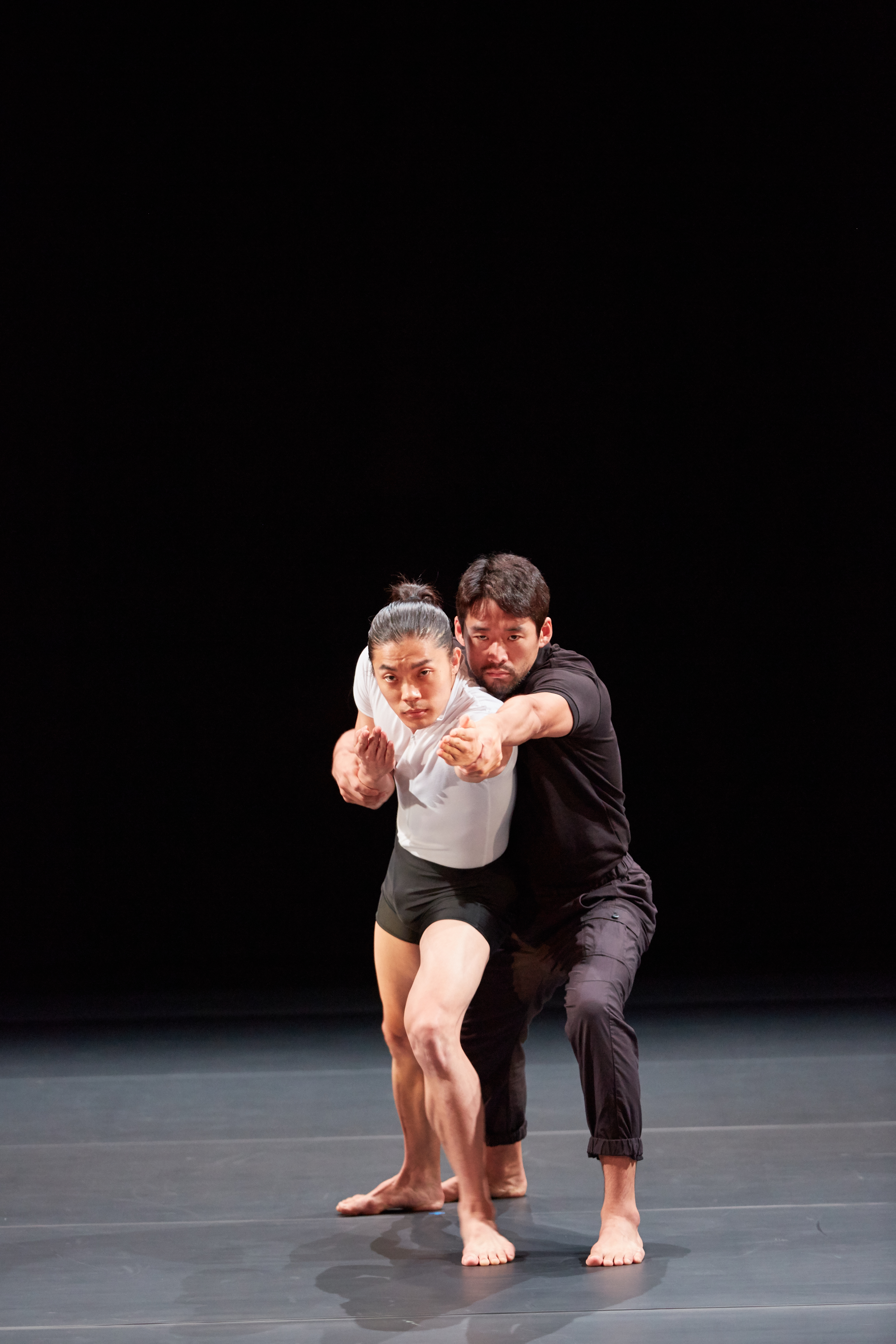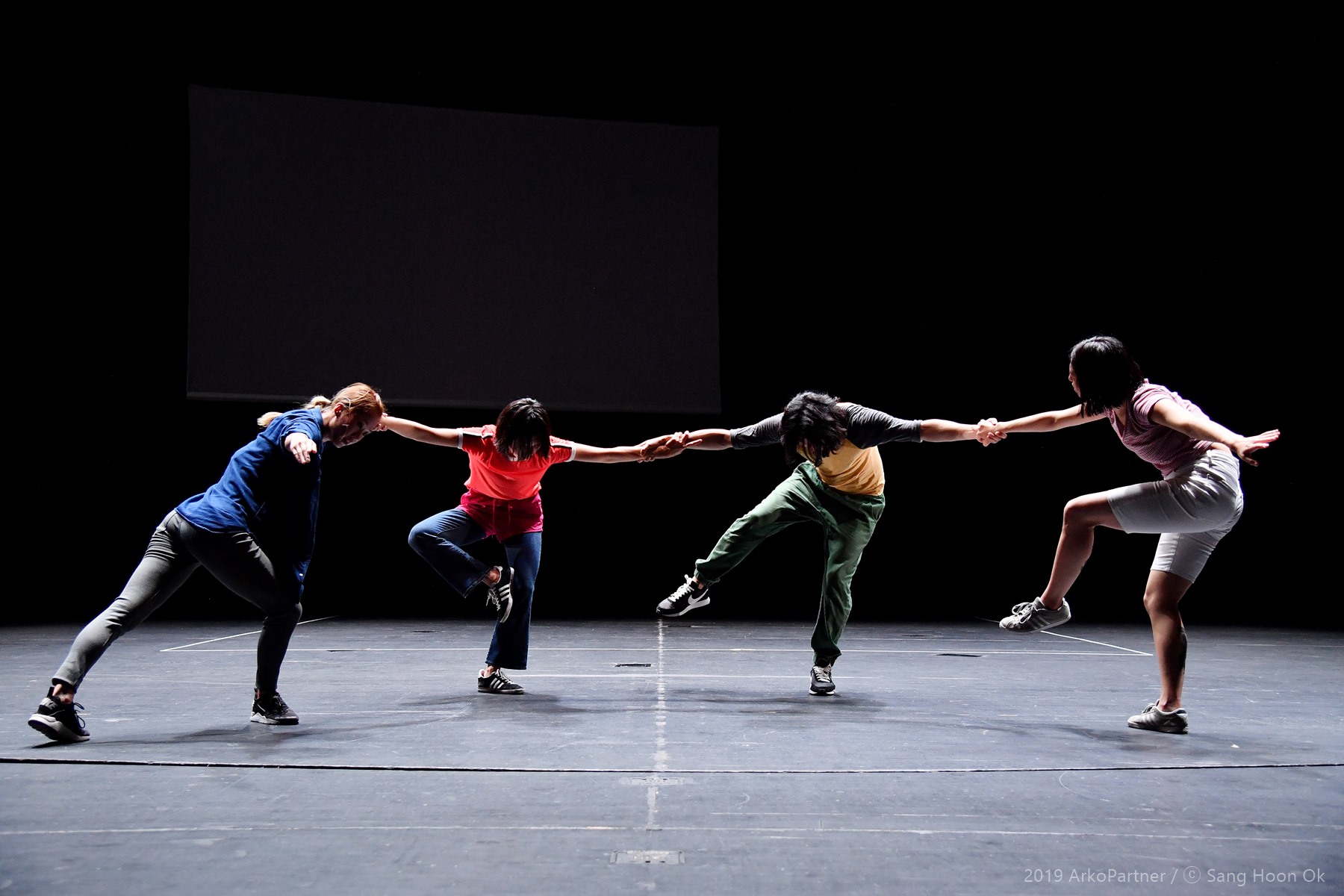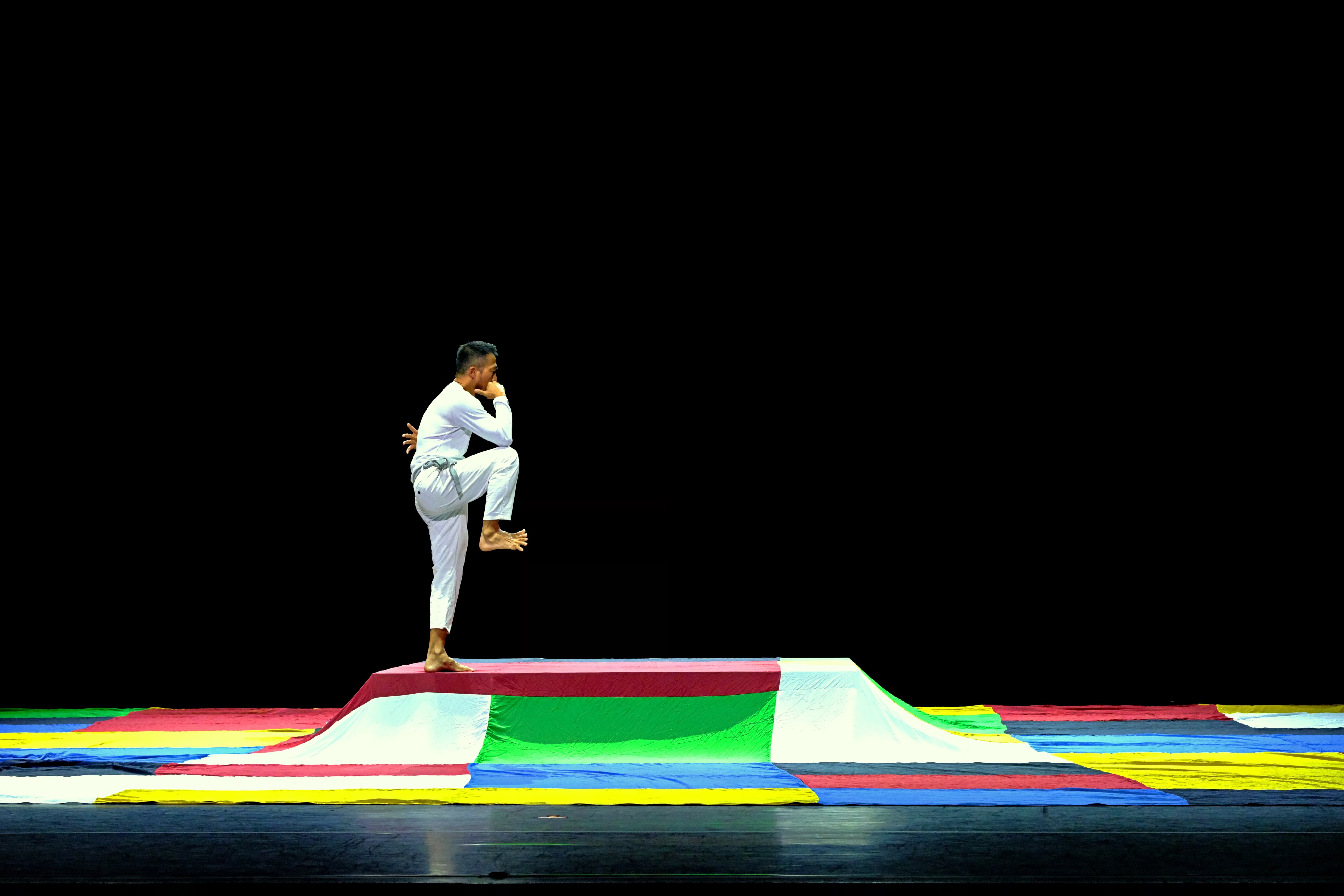Performance Info
Performance Info
About CompanyLyon Eun Kwon, is a choreographer and dancer based in Seoul, Korea. She won The French Embassy Prize for Young Choreographer for The Skill for me at the 2014 Yokohama Dance Collection EX in Japan. Homo Knitiens was presented as a showcase format at Centre National de la Danse Paris and invited to Dance Cross, Yokohama and Seoul Performing Arts Festival (SPAF). Her latest piece Glory won the Third Prize and the Audience Prize Special Mention at the Danse Élargie in Paris, 2016. With interests in body and movement, she has been creating her works to illuminate different phenomena and social gaze.
IntervieweeChoreographer Kwon, Lyon eun
Interview
Q: As a dancer and choreographer, you have participated in many different types of projects: dance performances, lecture performances, participatory exhibition performances, and even film. What is your background and how did this influence the work you do?
I studied modern dance and choreography at Hanyang University and Korea National University of Arts. When I was a student and even after graduation when I was working professionally, there were many publicly-funded dance projects that led me to great works. In 2012, I participated in Arts Council Korea’s Next Generation Choreographer Incubating Program for six to seven months. In 2014, I won the French Ambassador prize at the Yokohama Dance Collection EX for my work “Skill for Me,” which granted me the opportunity to participate in a six-month workshop at the National Choreographic Center of Montpellier as a participant in the ex.e.r.ce program. These diverse experiences transformed my thoughts and perspectives about dance.
Q: In 2016 you presented “Glory,” which discusses the issue of male dancers’ exemption from military conscription. It was described as a “Choreographic Documentary” that traced the treatment of the body in the Korean social system. “Glory” won awards at Paris’ Danse Élargie competition, which also simultaneously took place in Seoul to celebrate the 130th anniversary of diplomatic relations between Korea and France. Tell us about “Glory.”This military exemption system for dance concours grand prize winners still exists today. This dance documentary interviewed male dancers who participated in dance competitions to avoid compulsory military service. “Glory” poses questions about what we think of as dance: “This series of movements that we force our bodies to make because we think it is ‘dance’: Is it really dance?” “Is this the right way?” “And if so, what exactly is ‘dance’ anyway?” These young men dance to avoid joining the Army, but the practice and training they endure so closely resembles military training exercises. How strange that they choose to exhaust their bodies for the personal glory of first prize instead of the glory of protecting their country? By exposing this situation on stage, we questioned our ideas about dance and the body. Many choreographers who participated in the Danse Élargie with me couldn’t believe winning a dance concours could lead to military exemption. They kept asking, “Isn’t this a fiction of yours?”
Q: “You are so fine wherever you go” was a research project on the cultural identity of our bodies through dance.In Europe and Asia, “K-pop random dance games” are all the rage. K-pop fans visit pre-established locations at specific times and dance together to random K-pop songs and then disperse after the game is over. A new trend has also appeared in Korean tourism. Tourists visiting Korea used to stop by Gyeongbokgung or Seorak Mountain. Now, they participate in one-hour “Living as a K-pop Idol” programs and tour Korean entertainment companies. These phenomena made me realize that a dance culture exists in which people move through dance.
In the ’80s and ’90s, there were restrictions on foreign travel in Korea — so local bus tours were popular among Koreans. The highlight of every tour was, of course, although technically illegal, dancing wildly to loud music inside the moving bus.
“You are so fine wherever you go” analyzes the formation of temporary dance communities such as the K-pop random dance games and tour bus dance phenomena. It examined the bodies that participate in these dances, society’s attitude or gaze toward these dance phenomena, and how this gaze differs from the attitude people have towards dances performed inside a theater. Finally, it looks at what remains as the raw essence of dance once we take away the social gaze.
Q: The premise of your most recent work, “Tiny Round Clumsy,” is very original in its suggestion of cuteness as a survival strategy for artists during the Covid-19 pandemic. Where did you get this idea?“Tiny Round Clumsy” is a story about the thoughts and questions artists have had since the pandemic’s outset. I was worrying about how performance artists were going to survive during the pandemic shutdowns, when I read that cuteness can be a favorable condition for survival according to evolutionary psychology. I first became interested in “cuteness” when I found myself buying toys and snacks for my cat, even though I was struggling financially. Another time, my friend and I were buying groceries when we saw a cute cup being offered as a gift if you bought 20 cans of beer. My friend didn’t want any beer, but she wanted the cup. Why? Because it was cute. I was raising a cat for the very same reason. Because the cat was so cute and adorable, I wanted to keep it — even if it meant less food on my table. This made me realize that cute things had a better chance of survival, which led to my research on cuteness. I created my 20 stratagems on cuteness based on Sun Tzu’s “Thirty-Six Stratagems.” According to evolutionary psychology, people think that something is cute when it fulfills three criteria: it is tiny, round, and clumsy. “Tiny Round Clumsy” was an exploration of the possibilities of how “cuteness” can influence the survival and sustainability of the performing arts.
Q: It’s quite impressive how a conceptual theme runs through all your work. Please tell us how you choose your themes and dance methodologies, and the direction you would like your choreography to take.Most of the works we’ve discussed so far were commissioned works, so the themes did not spring from within me. Tourism, the coronavirus pandemic, the body seen from a historical perspective: These were topics that I was given to explore and branch out from. The themes of my early works were of my choosing, but, after a certain point, I’ve worked on themes handed to me by others. It’s a rather interesting process, locating the point where my ideas and the commissioned topics meet.
Q: “Tiny Round Clumsy” is comprised of cute, round gestures. “You are so fine wherever you go” is a structure based around movements developed from “Dance Dance Revolution”, K-pop random dance play, and tour bus dancing. The research of movement is an important process in any choreographer’s creative process. Which aspects do you find most important in your research?The dances I study have form. Nowadays, YouTube and mass media make it easy to obtain information, so it’s not difficult to conduct research on the form and movements of dance. However, the aspect of dance I observe and the reason for selecting a particular dance material and theme are always different. In my work, I don’t seek to create a new dance. Instead, I take existing forms and use choreography to change their structure.
Q: This year, you presented a participatory exhibit called “Code Name Bugok Hawaii” in which spectators were given pedometers and asked to follow performers’ dances; the participants were given lottery tickets corresponding to the number of steps they walked. What discoveries did you make from attempting this type of performance?“Code Name Bugok Hawaii” is an audience participatory performance based on the tour bus dance. I used audience participation, but let audience members choose whether they wanted to be performers or spectators. In any performance art, both spectators and performers are together from beginning to end and share the same experience. But in this exhibit, the performance continues for as long as the exhibit hall is open, so everyone experiences a different work depending on when they are present. I found this sense of time very interesting.
Q: What questions or concerns do you have as a choreographer these days?I am very intuitive when I work. I look at the work I’ve done and it’s only much later than I realize what my interests are. So it’s very difficult for me to say what I’m interested in or exactly what I’m aiming for at the moment. I find my interests through my given circumstances and the changes that occur in life, so I wait for such moments to happen. Nowadays, I try to be more intuitive about things that seem to have no meaning and things that spring forth from inside me. I am currently fascinated by superstition, and working on subjects that are considered less scientific, less academic, and less meaningful.
Production Details
Major Productions〈Glory〉
〈You are so fine wherever you go〉
〈Tiny Round Clumsy〉
〈skill for me〉
〈mom-meom-mum-mam〉
- 2018 K3-Tanzplan Hamburg Treffen Total Residence, Germany
- 2018 The Place ‘A Festival of Korean Dance’, UK
- 2016 Théâtre de la Ville ‘Danse Elargie,’ The Third Prize & the Audience Prize Special Mention, France
- 2014 Yokohama Red Brick Warehouse ‘Dance Cross’, Japan
- 2014 Jalalla Koreasti, Finland
- 2014 Paris, Montpellier, Rilleux-la-pape, Rennes Residence, France
- 2014 Yokohama Dance Collection EX, ‘French Embassy Prize’, Japan
Production Details
- Director
Kwon, Lyon eun
Choreographer Kwon Lyon Eun won the French Embassy Prize at Yokohama Dance Collection EX 2014 with “The Skill for Me.” She was invited to participate in a six-month residency program organized by the French National Choreography Centres and Institut Français. That December, at the National Choreography Centre in Paris, Kwon presented “Homo Knitiens,” which was later invited as an official performance of Dance Cross in Yokohama in July 2015 and the Seoul Performing Arts Festival in October 2015.
Kwon’s earlier work “CoCo” received Grand Prize at the Second Dance Collection awards, held at the 2008 Seoul Performing Arts Festival. “The Most Longest” won the Best Choreographer Prize as part of the 2010 Young Choreographers’ Creative Performance. In addition to being selected for the ARKO Young Art Frontier program in 2011 and 2012, Kwon was also selected for the 2012 Incubating Program for Emerging Choreographers. The more recent “Glory” was performed at Théâtre de la Ville in Paris for Danse Élargie 2016, where it won the third place prize and the special audience prize.









.jpeg)





 PREV
PREV
.jpg)












